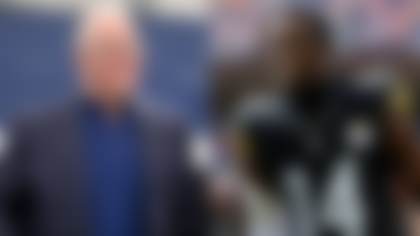The 2010 NFL Draft is over and it was a bigger success than any draft I've worked or attended as a member of the media. Everybody won in the new format.
Teams had time to evaluate their decisions, make adjustments and maneuver around the three-day process. In broadcasting my radio show from the floor of the draft for the past six years, I've never seen the fan enthusiasm during the last few rounds be as good as it was this year.
There was time to pay tribute to the greats like Gil Brandt, bring up former players and coaches to make selections and honor members of the armed forces. The NFL will never go back to the old format and that's a good thing.
Here are 10 things that struck me about the draft.
1. New format a hit
I didn't talk to one general manager or coach that didn't like the new three-day format. It provided time to make smart decisions, trades, restack draft boards and develop a conviction for a certain player.
Creating a three-day monster
From a football perspective, the new draft format drew mixed reviews from team officials. From a business standpoint, it was a huge success, writes Vic Carucci. **More ...**
Brandt and I sat together for all 255 picks for the fifth straight year and were better prepared to analyze the choices with all the prep time. Granted, Brandt's already the best that ever was when it comes to knowing the players, but you get the point.
In total, we interviewed 16 of the top picks live at Radio City Music Hall and at least another 20 on the phone.
2. No salary cap drives trades
In speaking with NFL Commissioner Roger Goodell before the draft, he loved the prospect of more trades in the offseason and during the draft. He said it brings more excitement to the fans.
Among the traded players I talked to during the draft (Kirk Morrison, LenDale White, and Jason Campbell), they all felt like they were getting drafted again and welcomed the fresh start. As one coach said, "Without a salary cap, it's a lot easier to move players and buy players for picks."
There were trades in the first round and picks were dealt in every round.
3. Some are playing a different game
Any decent football evaluator can gather enough information to put players in some kind of order or lay out a board. But can they play poker during the draft? I really respect a decision-maker who doesn't act impulsively and just grab a player when he's available, instead holding out as long as possible to get him later.
There's no greater example in this draft than Mike Holmgren passing on Colt McCoy three times before finally selecting the quarterback 85th overall. Holmgren demonstrated a great poker face throughout the early part of the draft and still got his quarterback of the future at a discounted price.
The Vikings made a nice move dropping out of the late first round and drafting CB Chris Cook, who they wanted all along. The Raiders traded back twice in the second round and got their targeted guy in DL Lamar Houston.
4. Oakland headed in right direction
Speaking of the Raiders, they sure acted like a team trying to right the ship in this draft. Getting Campbell was a brilliant move. After talking to the QB, I'm even more convinced the Raiders are climbing out of the black hole.
5. Seattle's dynamic draft
The Seahawks got their fans excited thanks to the draft. When the Chiefs passed on a tackle, Russell Okung fell right in their lap. When the Eagles moved ahead of them later in the first round, many thought it was for safety Earl Thomas. However, Philadelphia took Brandon Graham, which allowed Seattle to scoop up Thomas and his Ed Reed-like qualities. Then Golden Tate, the draft's third best receiver, drops right to them at the bottom of Round 2.
The relatively cheap trades that brought White and Leon Washington to the Seahawks when they passed on a running back. And when TE Anthony McCoy, who had a second-round grade, fell to them in the sixth round because of a failed drug test for marijuana, the moves were complete. I talked to McCoy after he was picked and he realized the money his mistake cost him and knows he has to work to do.
6. Going for seconds
When the second round ended, I was more convinced than ever to build a team here and not break the bank. Baltimore traded out of the first round and grabbed DE/LB Sergio Kindle and DT Terrence Cody. I had Kindle as a top 15 pick. While some teams failed him on their physical, the Ravens passed him and got a steal in the process.
Draft winners and losers
The Seattle Seahawks -- with their selections and veteran acquisitions via trade -- were the clear winners of the 2010 NFL Draft, writes Steve Wyche. **More ...**
The Patriots have been the leaders in focusing on the second round. This year, they hit another home run with TE Rob Gronkowski, DE Jermaine Cunningham and LB Brandon Spikes for the price of one top 5 pick.
While the Seahawks were criticized for trading back in the second round to acquire Charlie Whitehurst, they still ended up with receiver Golden Tate. I had seven players taken in the second round with first-round grades.
7. It's smart to take big guys early
Fifteen of the players taken in the first round were offensive or defensive linemen. There's so much pressure on high draft picks that it makes a lot of sense to take a lineman who can be plugged in right away to take heat off everyone.
In total, 41 guys who played in a three-point stance in college were selected in the first three rounds, many of which you will hear very little criticism about in 2010. An offensive lineman can always get help from a tight end, fullback or a protection call. A defensive lineman can always be in a rotation and play situational football. Meanwhile, the other high-profile positions can be exposed.
8. Right about some, wrong about others
The draft isn't an exact science, it's more of a beauty contest and each team sees players a lot different. But if all 32 teams pass on a guy at the end of the draft and he doesn't have a health or off-the-field issue, I have to admit I had the prospect pegged wrong.
Here are the guys I thought would go at least two rounds higher than they actually did: QB Cincinnati Tony Pike (sixth round to Carolina), Georgia Tech RB Jonathan Dwyer (sixth round to Pittsburgh), Mississippi State RB Anthony Dixon (sixth round to San Francisco), Mississippi State LB Jamar Chaney (seventh round to Philadelphia), North Carolina State DE Willie Young (seventh round to Detroit). Guess we can call them "value picks," or I just had the wrong grade on them.
9. Carolina has QBs on its mind
First, the Panthers said goodbye to Jake Delhomme and turned the offense over to Matt Moore. While that's the business, Carolina also lost several other starters in the offseason and replaced them with young backups. But who replaces those reserves? Draft picks.
General manager Marty Hurney did a masterful job of moving around to get more picks, but the Panthers selected two and a half quarterbacks in Jimmy Clausen, Tony Pike, and Armanti Edwards.
10. Tight ends trump fullbacks
There was a time that every team had a fullback and no one could conceive of a first- or second-down situation when the offense didn't have a nasty 240-pound guy on the field leading the way for the star running back. As this draft showed, times have changed.
I didn't have a true fullback on my top-125 list and the one came off the board at No. 139, when the Jets took Kentucky's John Conner. The Jets led the NFL in rushing attempts last season, so the pick makes sense, but most teams interested in running the ball were looking for more tight ends.
Twenty tight ends were taken as opposed to one true fullback. When teams like Baltimore, New England and St. Louis all take two tight ends each, it makes me realize more organizations want to run the ball from two-tight end sets than traditional one tight end, one fullback sets. As one coach said, we need to present a better passing threat to run the ball and two tight ends get that done.



